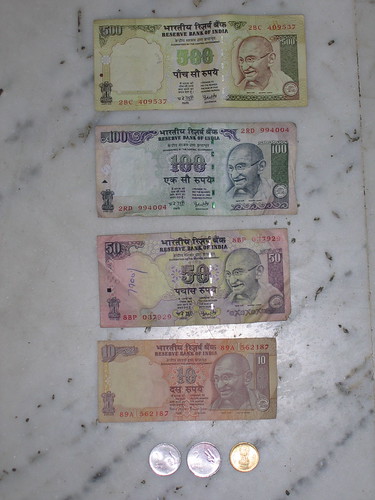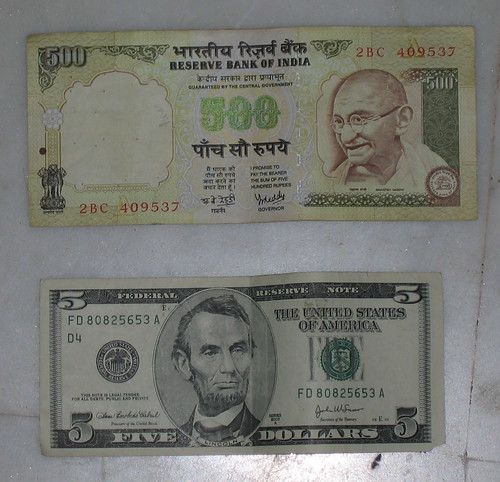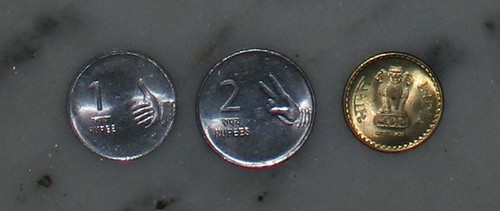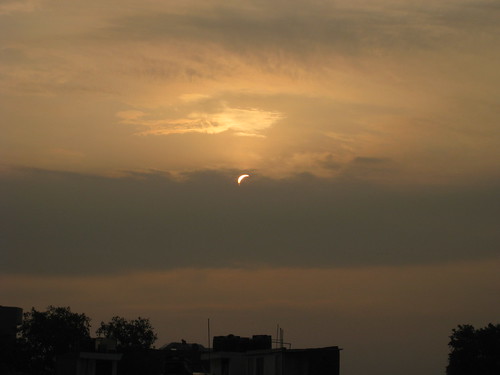I really love Indian cash; it's so well designed that I'm going to be a little sad to switch back to American money at the end of the summer. Here's a picture of some common denominations:
From top to bottom, the denominations are Rs. 500, 100, 50, 10. The coins, from left to right, are 1, 2, and 5 rupees. There are also notes with values of Rs. 1000, 20 and 5. In the US, we use different portraits to distinguish note values. In India, as you can see, they really, really like Gandhi, so they vary the size and overall color of the notes instead of having different portraits. I'm a really big fan of this system--it allows you to tally up a bunch of cash with only a quick glance, because you can easily distinguish between the different notes, even from a distance. In addition, if you keep the bills in your wallet organized by denomination, the differing sizes mean that all of the notes are visible, so you can jump right to the bill you need. Just for reference, here's a picture of the Rs. 500 note next to an American $5 bill. 
The Rs. 1000 notes are even bigger than the Rs. 500 bills, and are colored red. The Rs. 20 notes look similar to the Rs. 10 notes, except the numerals are in bright red. The Rs. 5 notes are always incredibly grungy, so it's tough to get a good look at them, but they're even smaller than the Rs. 10 note (they're about the size of Monopoly money), and are green.
Here's a closeup of the coins: 
I'm not as big a fan of the coins, because I find the Rs. 1 and 2 coins hard to distinguish by feel. However, you hardly ever need to use Rs. 1 and 2 coins because most things are in multiples of five rupees, and if they're not, people just round anyway (never in your favor, of course). Also, the fact that the coins have the "thumbs up" and "victory" hand signs on them always makes me happy. The Rs. 5 coin on the right of the picture is a little atypical; it is very new (which is atypical already), and the design is standard, but all the older coins are silver instead of gold. The Rs. 5 coins are about the size and thickness of an American nickel, but heavier. The Rs. 2 coin is about the size of a quarter.
The only thing I don't like about money in India is that there isn't enough of it, and I don't mean that the country is poor. The problem is that there simply aren't enough small bills. Encountering rickshaw drivers and storekeepers who can't make even small amounts of change is not uncommon, and my friends and I are always scrounging around for 10 rupee notes to hoard against the next time we have to use exact change. The general stores in neighborhood marketplaces are good places to get change, so I make a point of visiting the store every couple days to get change for Rs. 500, which gives me enough Rs. 100 notes to pay the rickshaw drivers. The drivers, in turn, leave me with enough 10- and 20-rupee notes to pay for lunch every day (Rs. 25), and to pay the occasional driver who doesn't have change. Other than that, however, I really like Indian money; whoever designed it clearly put a lot of thought into it, which makes it very functional.
As you've probably gathered from this post, my camera has been fixed. Yay! Now I can take wonderful photos again. I'll hopefully have some of my friends' shots from Agra and Jaipur up on Flickr soon, but until now, enjoy a shot of the solar eclipse (taken with Brian's camera): 
No comments:
Post a Comment